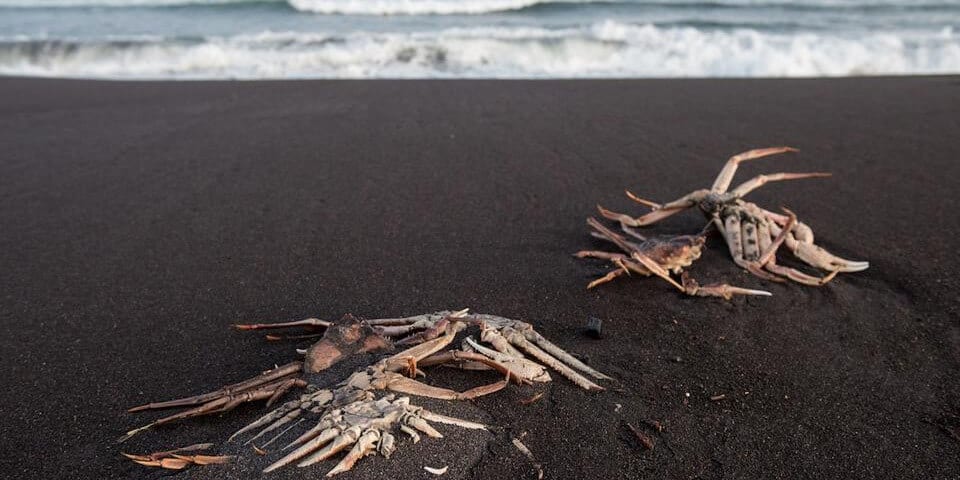In September, Russian surfers raised an alarm over contamination at Avacha Bay, Kamchatka region, which is in Russia’s Far East. People reported suspicious water color, smell and yellow foam, which covered the surface of the water. The geographer and administrator of Snowave Kamchatka surf school Ekaterina Dyba commented: “Pure water of Khalaktyrskiy Beach has become unsafe for people and, more likely, for marine life. During several weeks after contacted the water, all surfers have been suffering of eye pain. Blurry vision, vision worsening, dry eye syndrome. Sore throat. Many suffered from nausea, muscular weakness, fever. We rang alarm a couple of days ago, because the symptoms remained day to day.” She added that the water analysis has shown petroleum products and carbolic acid were above the norm 4 and 2 times respectively. Local citizens posted photos of dead marine animals – crabs, seals, urchins, octopuses, clams washed ashore by the sea.
Ecologists and activists raise a question: how did this happen?
Initially, three possible versions of the incident were considered. It was supposed that a seismic activity in the area could be a reason of contamination – about 160 volcanoes are located at Kamchatka Peninsula, many of them are active. However, the allegation was denied by seismologists; Russian authorities, not willing the information about the incident to be widely transmitted, keep defending this version.
Another version suggests that the death of marine life was caused by abnormal algae bloom. But the allegation is questioned by Greenpeace, yet, it has been also investigated. Greenpeace activists suppose that contamination was caused by the leak of chemicals from Russian military sites, situated near Avacha Bay.
The version was confirmed by the conclusions of the members of the Faculty of Chemistry of Lomonosov Moscow State University – probes of the water from Avacha Bay have shown highly toxic degradation products of the rocket fuel ‘heptyl’. Moscow ecologist Georgiy Kavanosan stated that the water tests, made in two different ways, have shown n-nitrosodimethylamine and tetramethyl-2-tetrazene which are the degradation products of heptyl which allows to claim that heptyl was the initial product. The expert supposes that the cause for these toxic substances to appear in the ocean was industrial only. It is highly likely that they were spilled into the ocean — and triggered the ‘red tides’ – via groundwater near Radygino military site (where since 90s 300 tons of the rocket fuel is kept) or from Russian military site in the city of Vilyuchinsk.
The incident of such a kind has happened in 2015. The symptoms of poisoning were the same: chemical burn of cornea, the injury of nervous and respiratory systems, a loss of consciousness, vomit, etc.
However, the rocket fuel is not the only possible chemical pollutant. Kamchatka governor Vladimir Solodov supposes that Kozelsky site, where the pesticides are stored deep in the ground, is no more appropriate for the use in agriculture and can be the dangerous source of contamination. The site was built and exploited in the Soviet era, in 1979-1981, later the facility was conserved. Despite the regulative rules, Kozelsky site was built near inhabitant area (the city of Petropavlovsk-Kamchatskiy), in a seismic area – near active Kozelsky volcano and in close proximity to the rivers which run into the ocean. As a result, 108 tons of dangerous chemicals are kept in the ground 38 km far from Petropavlovsk-Kamchatskiy, 20 tons of them are arsenic, others – chemical compounds containing mercury. In 2002 it was reported that protective membrane which isolates chemicals from the environment collapsed and pesticides fell into the groundwater. Despite the situation, Russian authorities have hidden the information regarding the type and the amount of toxins which have been contaminating the water for decades. Despite the reports made by environmental organizations, saying that the facility requires essential maintenance to be carried out, the problem was not resolved.
Greenpeace is not ready to draw conclusions regarding the source of chemical contamination of Avacha Bay yet. However, it is obvious that the consequences of human activity in the area will be sad. Ecologists estimated that as a result of the contamination of Avacha Bay 95% of benthos, which usually serve as food resource for marine mammals, have died. Sea otters and harbor seals will suffer the most.
Locals and Russian activists have tried to draw the government’s attention to environmental problems of Arctic for a long time. Regrettably, the disaster in Avacha Bay has become one in a list of similar incidents. For instance, this spring old reservoir in the city of Norilsk collapsed, and 21 thousand tons of diesel fuel spilled into the nearby Daldykan River. The water of bright red color was registered by satellite. Nornickel, Siberian industrial giant responsible for the catastrophe, tried to hide the fact of environmental disaster and claimed that all fuel had been collected in time. On the contrary, environmentalists assured that the booms were installed only 36 hours after the spill, which caused contamination of Lake Pyasino and Kara Sea. Officials downplayed the disaster, Nornickel contested the accusations over the spill. And half a month later, on July 13, Nornickel’s subsidiary Norilsktransgaz was blamed of leaking of 44 more tons of aviation fuel. As a result, a local lake near Tukhard settlement in Siberia was seriously polluted.
The most part of such catastrophes could have been prevented if the Russian authorities paid attention to the reasons beforehand. For instance, the inhabitants of the city of Baikalsk know that Lake Baikal, a natural site in Russia protected by UNESCO, the deepest body of fresh water is being contaminated with a waste from the nearby cellulose factory. The factory was built in 60s, on the lake shore, in 2013 the site was closed. During decades of non-stop operation, the facility accumulated 6,5 million tons(!) of ash mixed with chemical compounds resulted from the dispose of waste. Black liquid is stored in old reservoirs built on the shore of Baikal in the open air. And, as annual probes of the groundwater show, year by year the waste infiltrates the lake water. A seismic activity or heavy rains can trigger one more catastrophe, changing a landscape of Siberia forever.
While civilized countries are targeted at the reduction of negative influence on the environment, the series of recent incidents in Kamchatka and Siberia have demonstrated extremely non-effective Russian environmental politics. It would be naive to suppose that the catastrophes, reported by civil activists and ecologists, were the only cases when Russia violated natural resources laws. Disregard of the Russian authorities to environmental issues only confirms the fact that the Kremlin still gives priority to generating financial profits. Therefore, it is unlikely that the real causes of the disaster in Kamchatka will be revealed via official media.

